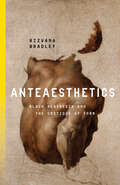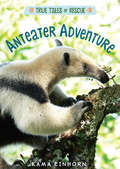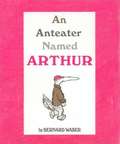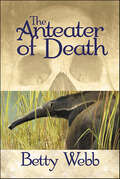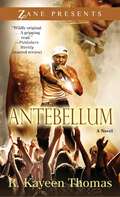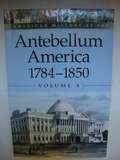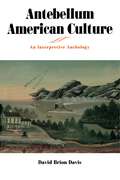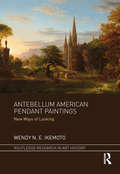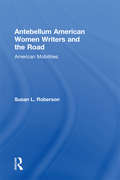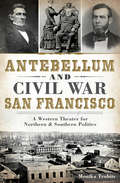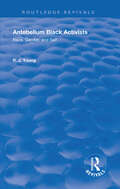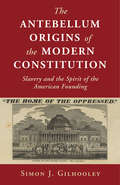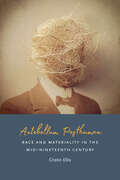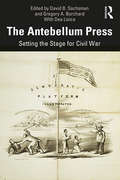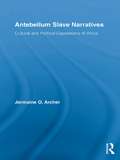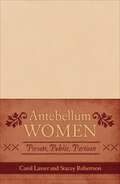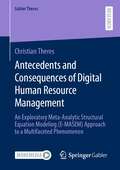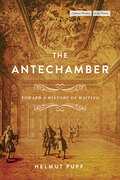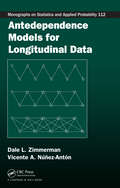- Table View
- List View
Ante Up (Dreamspun Beyond #8)
by Kim FieldingLove is a high-stakes game. A century and a half ago, Ante Novak died on a Croatian battlefield—and rose three days later as a vampire. Now he haunts Las Vegas, stealing blood and money from drunken gamblers and staying on the fringe of the powerful vampire organization known as the Shadows. His existence feels empty and meaningless until he meets beautiful Peter Gehrardi, who can influence others with his thoughts. An attraction flares instantly, bringing a semblance of life to Ante’s dead heart. But the Shadows want Peter too, and they’re willing to kill to get him. As Ante and Peter flee, they learn more about themselves and each other, and they discover that the world is a stranger place than either of them imagined. With enemies at their heels and old mistakes coming back to exact a price, how can Ante and Peter find sanctuary?
Anteaesthetics: Black Aesthesis and the Critique of Form (Inventions: Black Philosophy, Politics, Aesthetics)
by Rizvana BradleyIn Anteaesthetics, Rizvana Bradley begins from the proposition that blackness cannot be represented in modernity's aesthetic regime, but is nevertheless foundational to every representation. Troubling the idea that the aesthetic is sheltered from the antiblack terror that lies just beyond its sanctuary, Bradley insists that blackness cannot make a home within the aesthetic, yet is held as its threshold and aporia. The book problematizes the phenomenological and ontological conceits that underwrite the visual, sensual, and abstract logics of modernity. Moving across multiple histories and geographies, artistic mediums and forms, from nineteenth-century painting and early cinema, to the contemporary text-based works, video installations, and digital art of Glenn Ligon, Mickalene Thomas, and Sondra Perry, Bradley inaugurates a new method for interpretation—an ante-formalism which demonstrates how black art engages in the recursive deconstruction of the aesthetic forms that remain foundational to modernity. Foregrounding the negativity of black art, Bradley shows how each of these artists disclose the racialized contours of the body, form, and medium, even interrogating the form that is the world itself. Drawing from black critical theory, Continental philosophy, film and media studies, art history, and black feminist thought, Bradley explores artistic practices that inhabit the negative underside of form. Ultimately, Anteaesthetics asks us to think philosophically with black art, and with the philosophical invention black art necessarily undertakes.
Anteater Adventure (True Tales of Rescue)
by Kama EinhornAn up‑close look at what life is like the morning after a terrible hurricane for anteater Abi in this photo‑packed series exploring the stories and science behind animal sanctuaries. Abi takes readers behind the scenes of an anteater sanctuary in Belize in this nonfiction chapter book for elementary‑aged readers. Includes full‑color photos, graphics, and maps.
An Anteater Named Arthur
by Bernard WaberIn a story told through his mother's eyes, Arthur is seen as a sometimes annoying, but always lovable, anteater.
The Anteater of Death: A Zoo Mystery (Gunn Zoo Series #1)
by Betty Webb2009 Winner of the Arizona Book Award for Mystery/SuspenseIf Lucy, the pregnant Giant Anteater from Belize, didn't kill the man found dead in her enclosure at California's Gunn Zoo, who did? Zookeeper Teddy Bentley must find the real murderer before her furry friend is shipped off to another zoo in disgrace.Then another human bites the dust, the monkeys riot, and the wolves go nuts. Things get worse when the snooty folks at Gunn Landing Harbor attempt to evict Teddy from the Merilee, her beloved houseboat.That's just the beginning. Her father, on the lam from the Feds for embezzling millions, gets targeted by a local gangster; and Caro, Teddy's socialite and former beauty queen mother, who loathes Teddy's dangerous job, starts introducing her to eligible bachelors. Then Teddy herself becomes a target for murder.
Anteaters (Nature's Children)
by Lorien KiteIntroduces the reader to anteaters, where they live, what they eat, their young and more.
Antebellum: A Novel
by R. Kayeen ThomasA thought-provoking novel about African American culture seen through the eyes of a famous rapper who is transported to the days of slavery and forced to experience it firsthand.When Da Nigga is sent back in time, he finds himself a slave forced to live the life of his ancestors. A rapper in current time, Da Nigga must confront the reality of the African American experience as slavery challenges everything he holds dear from his fellow rappers and their lyrics, to the executives and their motives. Antebellum is the hard-hitting, gritty story of Da Nigga. From rap superstar to broken slave and back, Antebellum will have readers on the edge of their seats and keep them talking long after they put it down.
Antebellum America: 1784-1850 (American History By Era Series #Volume 4)
by William DudleyThe time between America's independence in 1783 and the year 1850 was an era of remarkable growth in territory and power for the new nation, as well as a time of social ferment and change. <P><P>Americans created a constitutional government, expanded westward, and grappled with the problem of slavery.
Antebellum American Culture: An Interpretive Anthology
by David Brion DavisFirst published in 1979, this volume offers students and teachers a unique view of American history prior to the Civil War. Distinguished historian David Brion Davis has chosen a diverse array of primary sources that show the actual concerns, hopes, fears, and understandings of ordinary antebellum Americans. He places these sources within a clear interpretive narrative that brings the documents to life and highlights themes that social and cultural historians have brought to our attention in recent years. Beginning with the family and the issue of socialization and influence, the units move on to struggles over access to wealth and power; the plight of "outsiders" in an "open" society; and ideals of progress, perfection, and mission. The reader of this volume hears a great diversity of voices but also grasps the unities that survived even the Civil War.
Antebellum American Culture: An Interpretive Anthology
by David Brion DavisFirst published in 1979, this volume offers students and teachers a unique view of American history prior to the Civil War. Distinguished historian David Brion Davis has chosen a diverse array of primary sources that show the actual concerns, hopes, fears, and understandings of ordinary antebellum Americans. He places these sources within a clear interpretive narrative that brings the documents to life and highlights themes that social and cultural historians have brought to our attention in recent years. Beginning with the family and the issue of socialization and influence, the units move on to struggles over access to wealth and power; the plight of "outsiders" in an "open" society; and ideals of progress, perfection, and mission. The reader of this volume hears a great diversity of voices but also grasps the unities that survived even the Civil War.
Antebellum American Pendant Paintings: New Ways of Looking (Routledge Research in Art History)
by Wendy N. IkemotoAntebellum American Pendant Paintings: New Ways of Looking marks the first sustained study of pendant paintings: discrete images designed as a pair. It opens with a broad overview that anchors the form in the medieval diptych, religious history, and aesthetic theory and explores its cultural and historical resonance in the 19th-century United States. Three case studies examine how antebellum American artists used the pendant format in ways revelatory of their historical moment and the aesthetic and cultural developments in which they partook. The case studies on John Quidor’s Rip Van Winkle and His Companions at the Inn Door of Nicholas Vedder (1839) and The Return of Rip Van Winkle (1849) and Thomas Cole’s Departure and Return (1837) shed new light on canonical antebellum American artists and their practices. The chapter on Titian Ramsay Peale’s Kilauea by Day and Kilauea by Night (1842) presents new material that pushes the geographical boundaries of American art studies toward the Pacific Rim. The book contributes to American art history the study of a characteristic but as yet overlooked format and models for the discipline a new and productive framework of analysis focused on the fundamental yet complex way images work back and forth with one another.
Antebellum American Women Writers and the Road: American Mobilities (Routledge Studies In Nineteenth Century Literature Ser. #5)
by Susan L. RobersonA study of American women’s narratives of mobility and travel, this book examines how geographic movement opened up other movements or mobilities for antebellum women at a time of great national expansion. Concerned with issues of personal and national identity, the study demonstrates how women not only went out on the open road, but participated in public discussions of nationhood in the texts they wrote. Roberson examines a variety of narratives and subjects, including not only traditional travel narratives of voyages to the West or to foreign locales, but also the ways travel and movement figured in autobiography, spiritual, and political narratives, and domestic novels by women as they constructed their own politics of mobility. These narratives by such women as Margaret Fuller, Susan Warner, and Harriet Beecher Stowe destabilize the male-dominated stories of American travel and nation-building as women claimed the public road as a domain in which they belonged, bringing with them their own ideas about mobility, self, and nation. The many women’s stories of mobility also destabilize a singular view of women’s history and broaden our outlook on geographic movement and its repercussions for other movements. Looking at texts not usually labeled travel writing, like the domestic novel, brings to light social relations enacted on the road and the relation between story, location, and mobility.
Antebellum and Civil War San Francisco: A Western Theater for Northern & Southern Politics (Civil War Ser.)
by Monika TrobitsWhen Americans migrated westward, they took their politics with them, making San Francisco a microcosm of the nation as the Civil War loomed. Spurred by the promise of gold, hungry adventurers flocked to San Francisco in search of opportunity on the eve of the Civil War. The city flourished and became a magnet for theater. Some of the first buildings constructed in San Francisco were theater houses, and John Wilkes Booth&’s famous acting family often graced the city&’s stages. In just two years, San Francisco&’s population skyrocketed from eight hundred to thirty thousand, making it an &“instant city&” where tensions between transplanted Northerners and Southerners built as war threatened the nation. Though seemingly isolated, San Franciscans took their part in the conflict. Some extended the Underground Railroad to their city, while others joined the Confederate-aiding Knights of the Golden Circle. Including a directory of local historic sites and streets, author Monika Trobits chronicles the dramatic and volatile antebellum and Civil War history of the City by the Bay. Includes photos
Antebellum at Sea: Maritime Fantasies in Nineteenth-Century America
by Jason BergerIn the antebellum years, the Western world&’s symbolic realities were expanded and challenged as merchant, military, and scientific activity moved into Pacific and Arctic waters. In Antebellum at Sea, Jason Berger explores the roles that early nineteenth-century maritime narratives played in conceptualizing economic and social transitions in the developing global market system and what these chronicles disclose about an era marked by immense change.Focusing on the work of James Fenimore Cooper and Herman Melville, Berger enhances our understanding of how the nineteenth century negotiated its own tenuous progress by portraying how a wide range of maritime stories lays bare disturbing experiences of the new. Berger draws on Slavoj Žižek&’s Lacanian notion of fantasy in order to reconsider the complex way maritime accounts operated in the political landscape of antebellum America, examining topics such as the function of maritime labor know-how within a transformation of scientific knowledge, anxiety produced by conflict between gender-specific and culture-specific forms of enjoyment, and how legal practices illuminate troubling juridical paradoxes at the heart of Polk-era political life.Addressing the ideas of the antebellum age from unexpected and revealing perspectives, Berger calls on the conception of fantasy to consider how antebellum maritime literature disputes conventional views of American history, literature, and national identity.
Antebellum Black Activists: Race, Gender, and Self
by R. J. YoungFirst published in 1996. In this volume the author has collected several published works to explore the ideas of manhood in America, Sojourner Truth, ties of ordinary blacks to those still in slavery and a study of the Northern African American community; new information on black activities in Canada and begins with an essay on the five elements of black community activity before the Civil War: churches, newspapers, conventions, organizations, and emigration which looks at of these "platforms for change" going through developmental stages from experimentation, adjustment and reaching maturity in the 1850’s.
The Antebellum Origins of the Modern Constitution: Slavery and the Spirit of the American Founding (Cambridge Studies on the American Constitution)
by Simon J. GilhooleyThis book argues that conflicts over slavery and abolition in the early American Republic generated a mode of constitutional interpretation that remains powerful today: the belief that the historical spirit of founding holds authority over the current moment. Simon J. Gilhooley traces how debates around the existence of slavery in the District of Columbia gave rise to the articulation of this constitutional interpretation, which constrained the radical potential of the constitutional text. To reconstruct the origins of this interpretation, Gilhooley draws on rich sources that include historical newspapers, pamphlets, and congressional debates. Examining free black activism in the North, Abolitionism in the 1830s, and the evolution of pro-slavery thought, this book shows how in navigating the existence of slavery in the District and the fundamental constitutional issue of the enslaved's personhood, Antebellum opponents of abolition came to promote an enduring but constraining constitutional imaginary.
Antebellum Posthuman: Race and Materiality in the Mid-Nineteenth Century
by Cristin EllisFrom the eighteenth-century abolitionist motto “Am I Not a Man and a Brother?” to the Civil Rights-era declaration “I AM a Man,” antiracism has engaged in a struggle for the recognition of black humanity. It has done so, however, even as the very definition of the human has been called into question by the biological sciences. While this conflict between liberal humanism and biological materialism animates debates in posthumanism and critical race studies today, Antebellum Posthuman argues that it first emerged as a key question in the antebellum era. In a moment in which the authority of science was increasingly invoked to defend slavery and other racist policies, abolitionist arguments underwent a profound shift, producing a new, materialist strain of antislavery. Engaging the works of Douglass, Thoreau, and Whitman, and Dickinson, Cristin Ellis identifies and traces the emergence of an antislavery materialism in mid-nineteenth century American literature, placing race at the center of the history of posthumanist thought. Turning to contemporary debates now unfolding between posthumanist and critical race theorists, Ellis demonstrates how this antebellum posthumanism highlights the difficulty of reconciling materialist ontologies of the human with the project of social justice.
The Antebellum Press: Setting the Stage for Civil War
by David B. Sachsman Gregory A. BorchardThe Antebellum Press: Setting the Stage for Civil War reveals the critical role of journalism in the years leading up to America’s deadliest conflict by exploring the events that foreshadowed and, in some ways, contributed directly to the outbreak of war. This collection of scholarly essays traces how the national press influenced and shaped America’s path towards warfare. Major challenges faced by American newspapers prior to secession and war are explored, including: the economic development of the press; technology and its influence on the press; major editors and reporters (North and South) and the role of partisanship; and the central debate over slavery in the future of an expanding nation. A clear narrative of institutional, political, and cultural tensions between 1820 and 1861 is presented through the contributors’ use of primary sources. In this way, the reader is offered contemporary perspectives that provide unique insights into which local or national issues were pivotal to the writers whose words informed and influenced the people of the time. As a scholarly work written by educators, this volume is an essential text for both upper-level undergraduates and postgraduates who study the American Civil War, journalism, print and media culture, and mass communication history.
Antebellum Slave Narratives: Cultural and Political Expressions of Africa (Studies in American Popular History and Culture)
by Jermaine O. ArcherThough America experienced an increase in a native-born population and an emerging African-American identity throughout the nineteenth century, African culture did not necessarily dissipate with each passing decade. Archer examines the slave narratives of four key members of the abolitionist movement—Frederick Douglass, William Wells Brown, Harriet Tubman and Harriet Jacobs—revealing how these highly visible proponents of the antislavery cause were able to creatively engage and at times overcome the cultural biases of their listening and reading audiences. When engaged in public sphere discourses, these individuals were not, as some scholars have suggested, inclined to accept unconditionally stereotypical constructions of their own identities. Rather they were quite skillful in negotiating between their affinity with antislavery Christianity and their own intimate involvement with slave circle dance and improvisational song, burial rites, conjuration, divination, folk medicinal practices, African dialects and African inspired festivals. The authors emerge as more complex figures than scholars have imagined. Their political views, though sometimes moderate, often reflected a strong desire to strike a fierce blow at the core of the slavocracy.
Antebellum Women: Private, Public, Partisan (American Controversies)
by Carol Lasser Stacey RoberttsonHow did diverse women in America understand, explain, and act upon their varied constraints, positions, responsibilities, and worldviews in changing American society between the end of the Revolution and the beginning of the Civil War? Antebellum Women: Private, Public, Partisan answers the question by going beyond previous works in the field. The authors identify three phases in the changing relationship of women to civic and political activities. They first situate women as "deferential domestics" in a world of conservative gender expectations; then map out the development of an ideology that allowed women to leverage their familial responsibilities into participation as "companionate co-workers" in movements of religion, reform, and social welfare; and finally trace the path of those who followed their causes into the world of politics as "passionate partisans." The book includes a selection of primary documents that encompasses both well-known works and previously unpublished texts from a variety of genre
Antecedents and Consequences of Digital Human Resource Management: An Exploratory Meta-Analytic Structural Equation Modeling (E-MASEM) Approach to a Multifaceted Phenomenon (Gabler Theses)
by Christian TheresDuring the last decades, a considerable amount of research has been directed towards explaining the concept of Digital Human Resource Management (DHRM). Yet, a holistic assessment of DHRM antecedents and consequences with respect to possible contextual contingencies is still missing. To this end, this thesis introduces a research framework illuminating the multifaceted phenomenon of DHRM from various perspectives. An exploratory four-step meta-analytic structural equation modelling (E-MASEM) approach tailored to address the domain-specific challenges of DHRM is introduced and applied. Results identify 32 constructs associated with the DHRM usage phenomenon which are categorized into DHRM antecedents and DHRM consequences. Findings reveal that user perceptions, expectations, attitudes, and intentions are essential in predicting DHRM usage while HRM service quality and user satisfaction are found crucial in explaining other DHRM consequences. Further, practitioners are informed about the relative importance of factors for both facilitating DHRM adoption and measuring DHRM success. Lastly, this thesis also contributes to the MASEM methodology by outlining a new approach to summarize statistical inferences from multiple moderator tests.
The Antechamber: Toward a History of Waiting (Cultural Memory in the Present)
by Helmut PuffHelmut Puff invites readers to visit societies and spaces of the past through the lens of a particular temporal modality: waiting. From literature, memoirs, manuals, chronicles, visuals, and other documents, Puff presents a history of waiting anchored in antechambers—interior rooms designated and designed for people to linger. In early modern continental Western Europe, antechambers became standard in the residences of the elites. As a time-space infrastructure these rooms shaped encounters between unequals. By imposing spatial distance and temporal delays, antechambers constituted authority, rank, and power. Puff explores both the logic and the experience of waiting in such formative spaces, showing that time divides as much as it unites, and that far from what people have said about early moderns, they approached living in time with apprehensiveness. Unlike how contemporary society primarily views the temporal dimension, to early modern Europeans time was not an objective force external to the self but something that was tied to acting in time. Divided only by walls and doors, waiters sought out occasions to improve their lot. At other times, they disrupted the scripts accorded them. Situated at the intersection of history, literature, and the history of art and architecture, this wide-ranging study demonstrates that waiting has a history that has much to tell us about social and power relations in the past and present.
Antedependence Models for Longitudinal Data (Chapman & Hall/CRC Monographs on Statistics and Applied Probability)
by Dale L. Zimmerman Vicente A. Núñez-AntónThe First Book Dedicated to This Class of Longitudinal ModelsAlthough antedependence models are particularly useful for modeling longitudinal data that exhibit serial correlation, few books adequately cover these models. By gathering results scattered throughout the literature, Antedependence Models for Longitudinal Data offers a convenient, system
Antegren: A Beacon of Hope
by Thomas J. Delong Terry Heymann Joshua D. MargolisThe CEO of Biogen Idec faces a set of difficult decisions regarding a promising drug for Multiple Sclerosis that is headed for early approval by the FDA. The first in a series, focuses on operational decisions triggered by the drive for early approval. Sparks discussion about a leader's economic, legal, and ethical responsibilities to multiple constituencies, and how a leader can guide a company to execute effectively, fulfilling those responsibilities, in a complex situation. Decisions facing the company include how to sustain credible research on the drug's efficacy and safety, how to increase manufacturing capacity to meet expected demand, and how to secure insurer reimbursement. All of these challenges arise against the backdrop of the accelerated approval process, uncertainty about what the FDA will ultimately decide, and whether the company should indeed pursue early approval.
Antegren: A Beacon of Hope (C)
by Thomas J. Delong Terry Heymann Joshua D. MargolisAn abstract is not available for this product.

